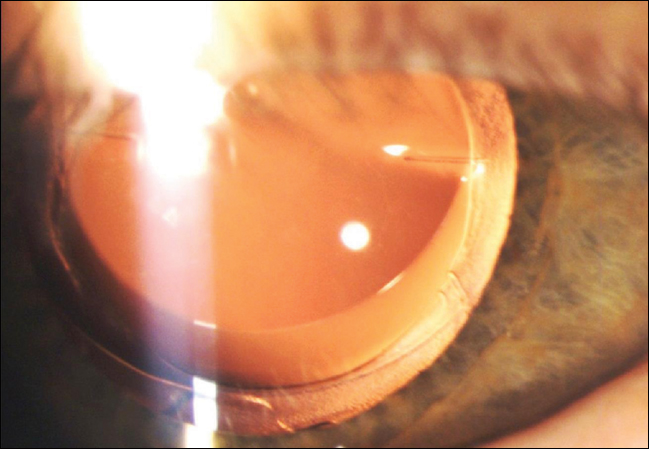Magnifying lens improves vision, quality of life in patients with advanced AMD and cataract
A foldable design makes the lens implantable through a small incision, similar to a normal IOL.
Click Here to Manage Email Alerts

A novel high-add IOL is a promising option for patients with advanced age-related macular degeneration and cataract, according to one surgeon.
“There have been several attempts to design lenses for AMD, but they were difficult to implant, required a large incision and had quite a few complications like intraocular pressure elevations or surgical-induced astigmatism. One of the advantages of the Lentis Max LS-313 MF80 (Oculentis) is that it is the size of a normal IOL. It is foldable, 11 mm long, with an optic of 6 mm. It goes through a 2.4-mm incision, and it is very easy to implant,” Andreas F. Borkenstein, MD, who was the first surgeon to implant this lens in Austria, told Ocular Surgery News.
Like other lenses in the Oculentis family, this IOL is sector-shaped and uses magnification to improve near vision through the inferior half of the optic, while the superior sector provides distance vision. It has a power add of 8 D, 6 D at spectacle plane, providing 1.5 times magnification at 25 cm to 30 cm and 3 times magnification at 12 cm to 15 cm.

“The scotoma is there, but since the periphery of the macula is fixating on a magnified image, through a process of neuroadaptation the patient is much less bothered by the scotoma,” Borkenstein said.
Significant vision improvement
The first clinical evaluation started in 2015. “Therefore, we have 3 years of experience by now,” Borkenstein said.
“They were patients with large atrophy, also geographic atrophy, [best corrected distance visual acuity] 1.3 to 0.5 logMAR (20/400 to 20/63) and [best corrected near visual acuity] worse than 0.8 logMAR (20/125), so very advanced cases with low vision. The main point of our study was to change the attitude of some of our colleagues who say to these patients, ‘Sorry, we cannot do anything. There’s no point in doing cataract surgery because you have advanced AMD, and it would be of no benefit for you.’ There are thousands of people who, deprived of hope, wait for death as a release,” he said.
The study aimed at demonstrating that there is realistic hope for these patients. By removing the cloudy lens, contrast sensitivity improves, and by implanting this IOL, near vision improves, allowing patients to eat easily, pour liquids, brush their teeth, identify pictures or write some letters.
In the 11 patients included in the first study in 2015, phacoemulsification was performed and the high-add IOL was implanted in the dominant or better eye. Three months after surgery, BCNVA was between 0.9 and 0.6 logMAR (20/160 and 20/80), and UDVA was between 0.4 and 0.2 logMAR (20/50 and 20/32). Near vision further improved at 6 and 12 months. Color perception and contrast sensitivity also improved significantly.
“Patients get used to it. Their brain learns to use the lens, and vision continues to improve over time, even after several months,” Borkenstein said.
In the first few days or weeks after surgery, while going through the process of neuroadaptation, patients reported problems with focusing on near objects. Many said they had to learn how to hold their book or mobile phone in a different way, but they all reported progressive improvement.
“The good thing was that they had no problems in the far distance and were able to walk and move with confidence when going for walks or doing other things outside. They had no halos. This was a concern of ours, about halos and glare, but none of the patients reported this kind of problem,” Borkenstein said.
Improved independence and life quality
In the study, subjective outcomes were evaluated with a scoring system in which 10 daily activities were rated 1 or 0 according to whether they could or could not be accomplished. The total score was an indication of the degree of independence in the daily routine of each patient. Preoperative and postoperative scores were compared.
“Significant improvement was reported in all cases. Eleven out of 11 patients valued their quality of life better than before,” Borkenstein said.
Seven patients had a 7-point improvement, three had a 3-point improvement, and one had a 1-point improvement. None of them said their life was equal or worse than before.
In a further study, Borkenstein and his group compared these results with those of AMD patients implanted with a monofocal IOL after cataract surgery.
“These patients report an improvement in distance vision but do not benefit from better near vision, so this is the big change this lens can make because it can improve so many of the daily activities that rely mostly on near vision,” Borkenstein said.
Another non-negligible advantage of this lens is that OCT and fundoscopy can be carried out without any problem.
For this surgery, the term MAGS, which stands for “magnifying surgery,” has been coined recently.
“We believe it will grow to become a new subcategory of surgery, addressing patients with retinal diseases. I’m so excited. It is such an interesting topic, and the best is to experience the happiness of these patients when they have more autonomy and quality of life,” Borkenstein said.
Oculentis is expected to launch the lens on the European market within the next year, he said. – by Michela Cimberle
For more information:
Andreas F. Borkenstein, MD, can be reached at Borkenstein & Borkenstein, Privatklinik d. Kreuzschwestern Graz, Kreuzgasse 35, 8010 - Graz, Austria; email: crustalith@gmx.at.
Disclosure: Borkenstein reports no relevant financial disclosures.
